First, all credits to the designer of this circuit (Takajin)
Use google translate as the site is Japanese.
DIY Headphone Amplifier YAHA MODIFY: new_western_elec
The circuit is at the bottom of the page, 0dBHyCAA ( 0db gain, Hybrid class AA)
For quite a few months I have developed a liking for the combination of the tube pre and solid state power amp. My reference amplifiers are the JLH69 and the Elvee’s Circlophone. Both amplifiers are praised a lot as all of us know. I wanted to use a tube pre and see what it can add to the whole audio experience. After few days of surfing, by chance I got to see this circuit from a Japanese website. There are a lot of Chinese, Russian, and Japanese websites, which has great audio schematics,but generally not noticeable doing a regular google search.(Lincor tda7294 current feedback amplifier is an example for such a beautiful schematic from Russia). Most of these are not displayed when you do a regular google search like tube preamp circuit. What I generally do a image search rather than websearch, or use pinterest, and then go into the web, translate to English. It was by pure luck that I got to see this schematic by Takajin. While all the low voltage hybrid headphone circuits are using 12au7 as a voltage gain stage, this designer uses 12au7 as a cathode follower. Infact, his earlier versions on the same page, describe 12au7 as traditional anode gain stage, and he was not happy with the sound as it was too distorted and its extremely sensitive to power supply noise.After experimentation, he found using the tube as a cathode follower eliminates most problems, as well as infusing the tube flavor.
I was intrigued by the use of Ecc82 as a cathode follower, at a puny 12 volt and a class AA technics buffer as the following stage.The frequency plot and FFT convinced me that this will work.Later I found that the author has sold several kit versions of the same and the feedbacks were too good. So, I wanted to give this a try. I don’t use it for headphone usage rather I use it as a tube buffer for elvee circlpohone. It’s a fairly easy build, and it took me a week to complete. I used ne5532 for both V amp and C amp. The author claims better opamps will yield better sonics. I will try upgrading opamps after lockdown is eased.
I strongly recommend the shunt regulated supply than a wallwart 12 volt supply. There is noticeable difference in the zener shunt power supply when compared to a smps 12 volt. There is something magical with this tube pre and elvee circlophone combination. I suggest anyone with a 12au7 or ecc82 to go ahead and build this. It has got stunning imaging, with vocals true to life. Non fatiguing sound which you will enjoy for hours.
Happy Building!
Ps. The only changes I made are 1 . 10 ohms resistor for RC filter on power supply instead of 82 ohms.
2. Grid stopper resistor 3.3k 3. The output resistor is between 10 ohms t0 120 ohms, higher values will prevent oscillation, but reduce volume on headphones. I have fixed mine at 100 ohms, since it is for preamp application.
Use google translate as the site is Japanese.
DIY Headphone Amplifier YAHA MODIFY: new_western_elec
The circuit is at the bottom of the page, 0dBHyCAA ( 0db gain, Hybrid class AA)
For quite a few months I have developed a liking for the combination of the tube pre and solid state power amp. My reference amplifiers are the JLH69 and the Elvee’s Circlophone. Both amplifiers are praised a lot as all of us know. I wanted to use a tube pre and see what it can add to the whole audio experience. After few days of surfing, by chance I got to see this circuit from a Japanese website. There are a lot of Chinese, Russian, and Japanese websites, which has great audio schematics,but generally not noticeable doing a regular google search.(Lincor tda7294 current feedback amplifier is an example for such a beautiful schematic from Russia). Most of these are not displayed when you do a regular google search like tube preamp circuit. What I generally do a image search rather than websearch, or use pinterest, and then go into the web, translate to English. It was by pure luck that I got to see this schematic by Takajin. While all the low voltage hybrid headphone circuits are using 12au7 as a voltage gain stage, this designer uses 12au7 as a cathode follower. Infact, his earlier versions on the same page, describe 12au7 as traditional anode gain stage, and he was not happy with the sound as it was too distorted and its extremely sensitive to power supply noise.After experimentation, he found using the tube as a cathode follower eliminates most problems, as well as infusing the tube flavor.
I was intrigued by the use of Ecc82 as a cathode follower, at a puny 12 volt and a class AA technics buffer as the following stage.The frequency plot and FFT convinced me that this will work.Later I found that the author has sold several kit versions of the same and the feedbacks were too good. So, I wanted to give this a try. I don’t use it for headphone usage rather I use it as a tube buffer for elvee circlpohone. It’s a fairly easy build, and it took me a week to complete. I used ne5532 for both V amp and C amp. The author claims better opamps will yield better sonics. I will try upgrading opamps after lockdown is eased.
I strongly recommend the shunt regulated supply than a wallwart 12 volt supply. There is noticeable difference in the zener shunt power supply when compared to a smps 12 volt. There is something magical with this tube pre and elvee circlophone combination. I suggest anyone with a 12au7 or ecc82 to go ahead and build this. It has got stunning imaging, with vocals true to life. Non fatiguing sound which you will enjoy for hours.
Happy Building!
Ps. The only changes I made are 1 . 10 ohms resistor for RC filter on power supply instead of 82 ohms.
2. Grid stopper resistor 3.3k 3. The output resistor is between 10 ohms t0 120 ohms, higher values will prevent oscillation, but reduce volume on headphones. I have fixed mine at 100 ohms, since it is for preamp application.
Attachments
-
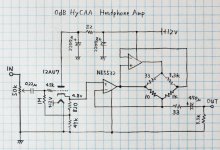 1.SCHEMATIC.jpg166.7 KB · Views: 600
1.SCHEMATIC.jpg166.7 KB · Views: 600 -
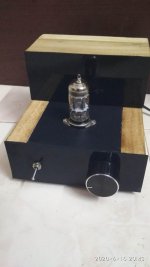 woodworked 5.jpg192 KB · Views: 334
woodworked 5.jpg192 KB · Views: 334 -
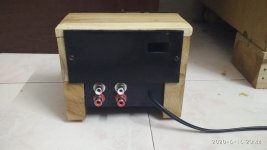 woodworked 2.jpg372.7 KB · Views: 229
woodworked 2.jpg372.7 KB · Views: 229 -
 woodworked 3.jpg340.6 KB · Views: 279
woodworked 3.jpg340.6 KB · Views: 279 -
 10 .INITIAL BUILD BOTTOM.jpg527.3 KB · Views: 281
10 .INITIAL BUILD BOTTOM.jpg527.3 KB · Views: 281 -
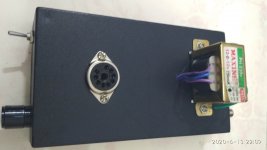 9. INITIAL bUILD TOP.jpg445.2 KB · Views: 436
9. INITIAL bUILD TOP.jpg445.2 KB · Views: 436 -
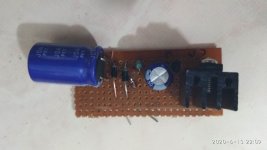 8.zener shunt PS.jpg343.8 KB · Views: 433
8.zener shunt PS.jpg343.8 KB · Views: 433 -
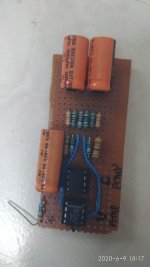 6 .CLASS AA top.jpg243.1 KB · Views: 468
6 .CLASS AA top.jpg243.1 KB · Views: 468 -
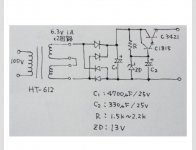 2.ZENER PS SCHEMATIC.jpg79.8 KB · Views: 503
2.ZENER PS SCHEMATIC.jpg79.8 KB · Views: 503 -
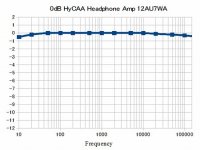 3. FREQ RESP.jpg28.3 KB · Views: 369
3. FREQ RESP.jpg28.3 KB · Views: 369
Just for fun, try using a JFET source follower instead of the 12AU7.
See what it sounds like.
And leave the 12AU7 filaments wired up so we can still see the pretty glow.
But I really do like tubes.
The only places I use solid state devices:
solid state diodes in the B+ supply, with Choke input B+ filter whenever possible;
solid state current sink in the cathode coupled phase invertor;
and for single ended amplifiers, solid state plate load in the driver stage.
Tubes everywhere else.
(The right tool for the right job)
Just my opinion.
See what it sounds like.
And leave the 12AU7 filaments wired up so we can still see the pretty glow.
But I really do like tubes.
The only places I use solid state devices:
solid state diodes in the B+ supply, with Choke input B+ filter whenever possible;
solid state current sink in the cathode coupled phase invertor;
and for single ended amplifiers, solid state plate load in the driver stage.
Tubes everywhere else.
(The right tool for the right job)
Just my opinion.
Last edited:
Some time ago I read about the YAHA amplifier that had attracted me for the circuit simplicity.
There are variations on the theme of R-network after the opamp to optimize the output impedance.
But in my opinion the problem is the 12au7 driver tube which at that voltage acts as a "bottleneck"
There are variations on the theme of R-network after the opamp to optimize the output impedance.
But in my opinion the problem is the 12au7 driver tube which at that voltage acts as a "bottleneck"
I too was very skeptical about the operating voltage being very low. I already built another popular project which uses 12au7 followed by a irf510 . There,the 12au7 was used for voltage gain. I was not happy with the result, in that it was noisy and the sound was very mellow,with loss of highs. In contrast,here 12au7 is used as a cathode follower, with no gain and as the proverbial goes,the proof of the pudding is in the eating. I am totally convinced after listening to it.
A jfet can be tried,yes, and may be in due course. But I would like the tube to glow as well as conduct music. ☺️
This particular tube,12au7 ,has been tested and plotted for low voltages,and its quite linear.
A jfet can be tried,yes, and may be in due course. But I would like the tube to glow as well as conduct music. ☺️
This particular tube,12au7 ,has been tested and plotted for low voltages,and its quite linear.
Attachments
Last edited: